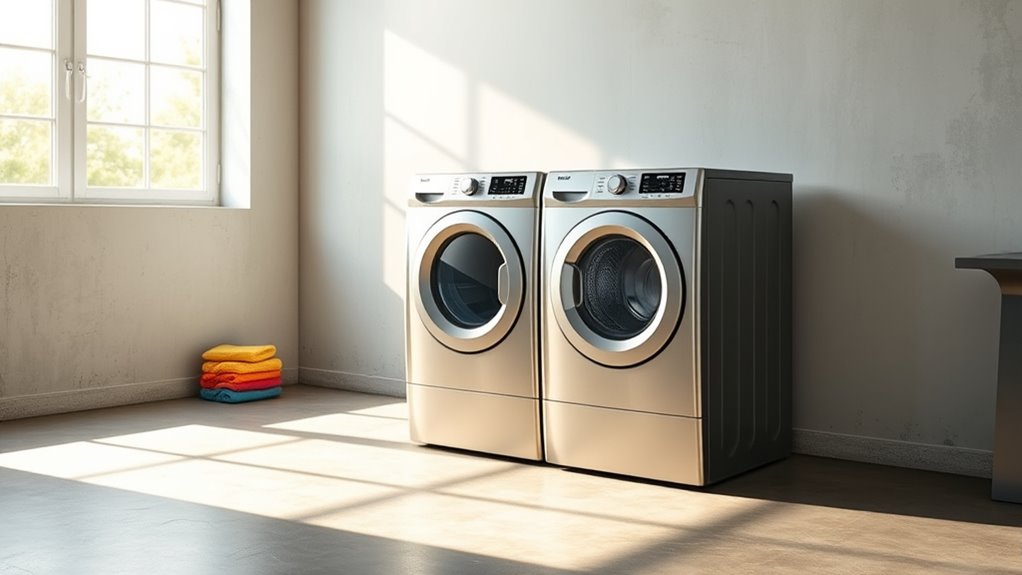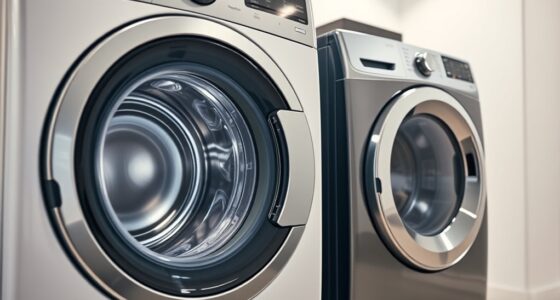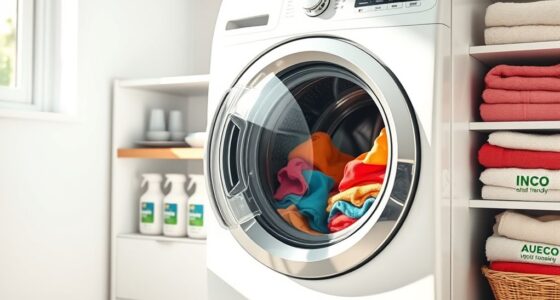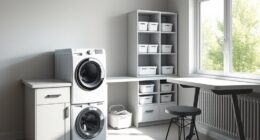When choosing a heat-pump dryer for energy efficiency, focus on models that have high energy ratings and lower annual operating costs. Opt for units with proper ventilation and consider compact options if space is limited. Keep in mind that while they may have a higher initial price, you’ll save money long-term through lower utility bills and gentler laundry cycles. To discover more tips on selecting the best model, continue exploring the key features and installation tips.
Key Takeaways
- Compare energy consumption ratings and annual operating costs to identify the most efficient models.
- Look for models with advanced eco-friendly features that enhance energy savings.
- Ensure proper installation and ventilation to maximize the dryer’s efficiency and lifespan.
- Consider the size and capacity to suit your laundry needs without compromising efficiency.
- Factor in noise levels and maintenance requirements for sustainable, quiet operation.
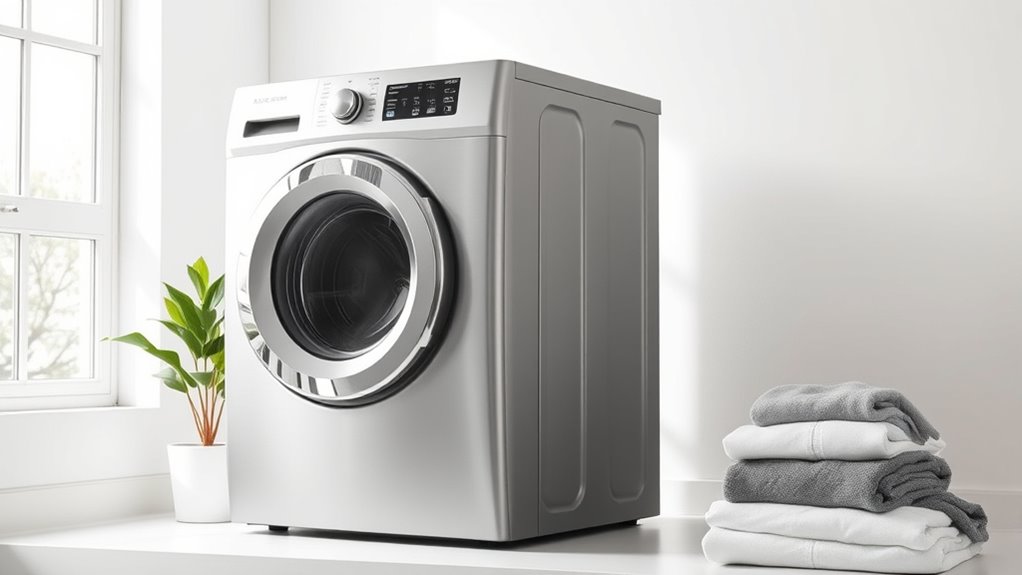
When selecting a heat-pump dryer, understanding how it differs from traditional dryers can help you make an informed choice. Unlike conventional models that use high heat and vent moisture outside, heat-pump dryers recycle and extract moisture using a refrigeration cycle. This process consumes considerably less energy, leading to notable energy savings over time. You’ll find that these dryers operate at lower temperatures, which not only saves electricity but also reduces wear and tear on your clothes, extending their lifespan. Recognizing these benefits can motivate you to prioritize a heat-pump dryer, especially if you’re aiming to cut down on utility bills and minimize your environmental impact.
However, before you make a purchase, it’s important to contemplate installation considerations. Heat-pump dryers typically require a dedicated space with proper ventilation, even though they don’t vent outside like traditional dryers. You’ll want to ensure there’s enough room for airflow and that the area maintains a consistent temperature. Some models may be more compact, fitting into smaller laundry rooms, while others might need more space for maximum performance. Also, check the power requirements; most heat-pump dryers run on standard household outlets, but some may need additional electrical considerations, especially if they have advanced features or larger capacities. Proper installation not only ensures efficient operation but also helps maintain the longevity of the machine.
Another aspect to think about is the initial cost versus long-term savings. Heat-pump dryers tend to be more expensive upfront, but their energy efficiency translates into lower utility bills over the years. When evaluating options, compare the energy consumption ratings and estimated annual operating costs. Keep in mind that some models might have longer drying cycles, which, although energy-efficient, could be less convenient if you’re used to quicker drying times. Balancing these factors with your household’s laundry habits will help you select a model that fits your budget and needs.
It’s also worth pondering the noise level and maintenance requirements. Heat-pump dryers generally operate more quietly than traditional models, which is a bonus if your laundry area is near living spaces. Regular cleaning of filters and the condenser is essential to maintain efficiency, so choose a model that offers easy access to these components. Additionally, considering the energy-efficient features of the dryer can further optimize your savings. Taking time to understand the installation considerations and energy-saving features ensures you get the most out of your investment. Ultimately, a heat-pump dryer can be a smart, eco-friendly choice that saves you money, reduces energy consumption, and fits well into your living space with proper setup.
Frequently Asked Questions
How Do Heat-Pump Dryers Compare in Lifespan to Traditional Dryers?
Heat-pump dryers typically last about 10 to 15 years, which is comparable to traditional dryers. They often offer better energy savings over their lifespan, reducing your utility bills. Plus, they tend to operate with lower noise levels, making them more convenient for daily use. With proper maintenance, a heat-pump dryer can provide long-lasting, efficient drying while saving energy and keeping noise to a minimum.
Are Heat-Pump Dryers Suitable for Large Families or Heavy Laundry Loads?
Think of a heat-pump dryer as a reliable workhorse that can handle large family and heavy laundry loads with ease. These dryers are designed to be gentle yet powerful, making them suitable for big households. While they may take a bit longer, their energy efficiency saves you money in the long run. So, if you’ve got a large family, a heat-pump dryer is definitely a smart choice to keep up with heavy laundry demands.
What Maintenance Is Required to Keep a Heat-Pump Dryer Running Efficiently?
To keep your heat-pump dryer running efficiently, you should regularly clean the filter to prevent lint buildup and guarantee good airflow. Additionally, inspect the vent for blockages or damage, and clean it if necessary. These simple maintenance steps help maintain peak performance, extend the dryer’s lifespan, and save energy. Make it a habit to check and clean these parts every few months to keep your dryer working smoothly.
Can Heat-Pump Dryers Dry Clothes Quickly Like Conventional Models?
Don’t judge a book by its cover—heat-pump dryers may take longer, but they’re worth the wait. While they may have slightly longer drying times than conventional models, they still effectively dry your clothes, helping you save energy. With proper use, you’ll notice significant energy savings over time. If you need quick drying, consider adjusting settings or using a pre-dry cycle, but overall, these dryers balance efficiency and performance well.
Are There Specific Installation Requirements for Heat-Pump Dryers?
Yes, there are specific installation requirements for heat-pump dryers. You need to guarantee proper ventilation requirements, like adequate airflow and exhaust placement, to prevent overheating. Additionally, check the electrical specifications, including voltage and outlet type, to match the dryer’s needs. Follow the manufacturer’s instructions carefully, and consider professional installation to ensure your dryer operates safely and efficiently. Proper setup helps maximize performance and prolongs the unit’s lifespan.
Conclusion
Choosing a heat-pump dryer is like finding a trusty sidekick that saves energy and keeps your clothes fresh. It’s an investment that pays off by reducing utility bills and helping the environment. With its efficiency and gentle drying process, you’ll enjoy laundry days more than ever. So, go ahead—embrace this smart choice and turn your laundry routine into a breeze, just like a cool wind on a warm day.
